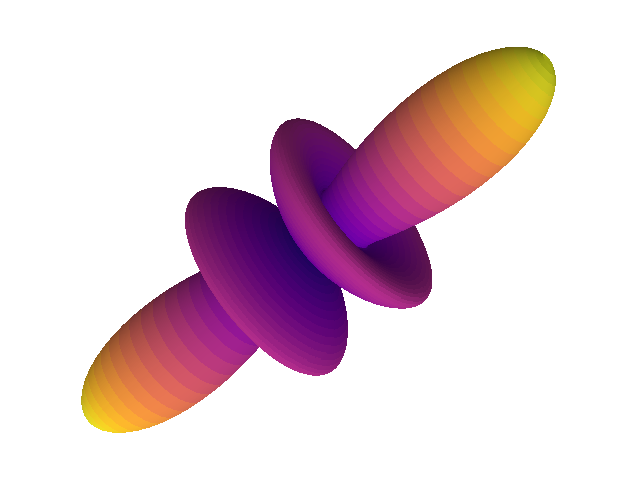Simulation of k-multipole emission patterns
In this tutorial, an electric octupole transition (E3) of a vastly simplified atom, consisting of only two magnetic substates, is excited and the photon scattering rate is calculated for all emission angles.
import numpy as np import qspec as qs import qspec.simulate as sim import matplotlib.pyplot as plt f_eg = 7e8 # Transition frequency a_eg = 10. # Einstein coefficient g_hyper = [0.] # HFS A-constant of the g state e_hyper = [5.] # HFS A-constant of the e state i, jg, je = 0., 2., 5. dm = 1 # The change of the m quantum number g = sim.State(0., parity='e', j=jg, i=i, f=jg + i, m=jg + i, hyper_const=g_hyper, label='g') e = sim.State(f_eg, parity='o', j=je, i=i, f=je + i, m=jg + i + dm, hyper_const=e_hyper, label='e') states = [g, e] decay = sim.DecayMap(labels=[('g', 'e')], a=[a_eg], k_max=int(je - jg)) atom = sim.Atom(states=states, decay_map=decay) print(atom.get_multipole_types('g', 'e')) # >>> {'e3'} intensity = 1e3 pol_eg = sim.Polarization([1., 0, 1j], vec_as_q=False) laser_eg = sim.Laser(freq=f_eg, polarization=pol_eg, intensity=intensity, k=[0., 1., 0.]) B = [0., 0., 1e-6] # The B-field vector env = sim.Environment(B=B) inter = sim.Interaction(atom=atom, lasers=[laser_eg, ], environment=env, delta_max=1000.) t = np.linspace(0., 1., 301) # Create an array of times to simulate y0 = qs.unit_vector(0, 2, dtype=float) # Create initial population [1., 0.] rho = inter.master(t, y0=y0) y = sim.density_matrix_diagonal(rho, axis=1)[0] plt.figure(figsize=(6, 4)) plt.plot(t, y[0], label=g.label) plt.plot(t, y[1], label=e.label) plt.legend() plt.xlabel(r'Time ($\mu$s)') plt.ylabel('Population') plt.show()
Using atom.scattering_rate, we can calculate the photon scattering for the angle pairs
(θ, φ) to generate a 3D plot of the emission pattern.
n_theta, n_phi = 128, 256 theta = np.linspace(0., np.pi, n_theta) phi = np.linspace(0., 2 * np.pi, n_phi) theta, phi = np.meshgrid(theta, phi, indexing='ij') r = atom.scattering_rate(rho[0, :, :, -1], theta=theta, phi=phi, x_vec=None, axis=0) r /= np.max(r) r = r.reshape((n_theta, n_phi)) x = r * np.sin(theta) * np.cos(phi) y = r * np.sin(theta) * np.sin(phi) z = r * np.cos(theta) fig, ax = plt.subplots(subplot_kw={'projection': '3d'}) cm = plt.get_cmap('plasma') ax.plot_surface(x, y, z, facecolors=cm(r), rcount=128, ccount=256, linewidth=0, antialiased=False) xyz_lim = 0.7 ax.set_xlim(-xyz_lim, xyz_lim) ax.set_ylim(-xyz_lim, xyz_lim) ax.set_zlim(-xyz_lim, xyz_lim) ax.set_box_aspect((1., 1., 1.)) ax.set_axis_off() plt.subplots_adjust(left=0., bottom=0., right=1., top=1.) plt.show()











